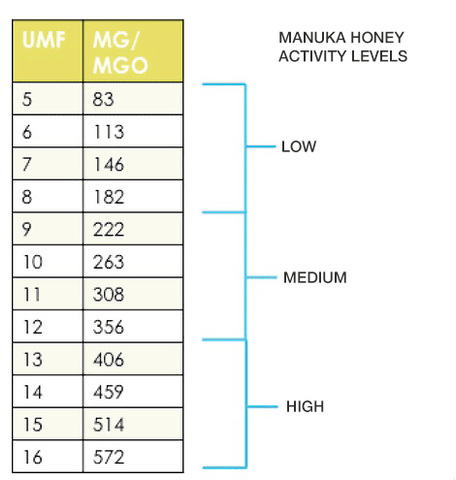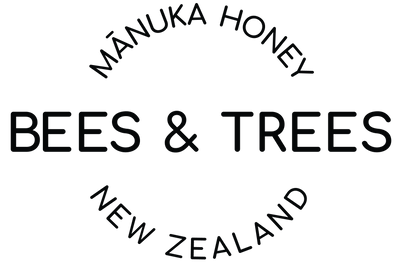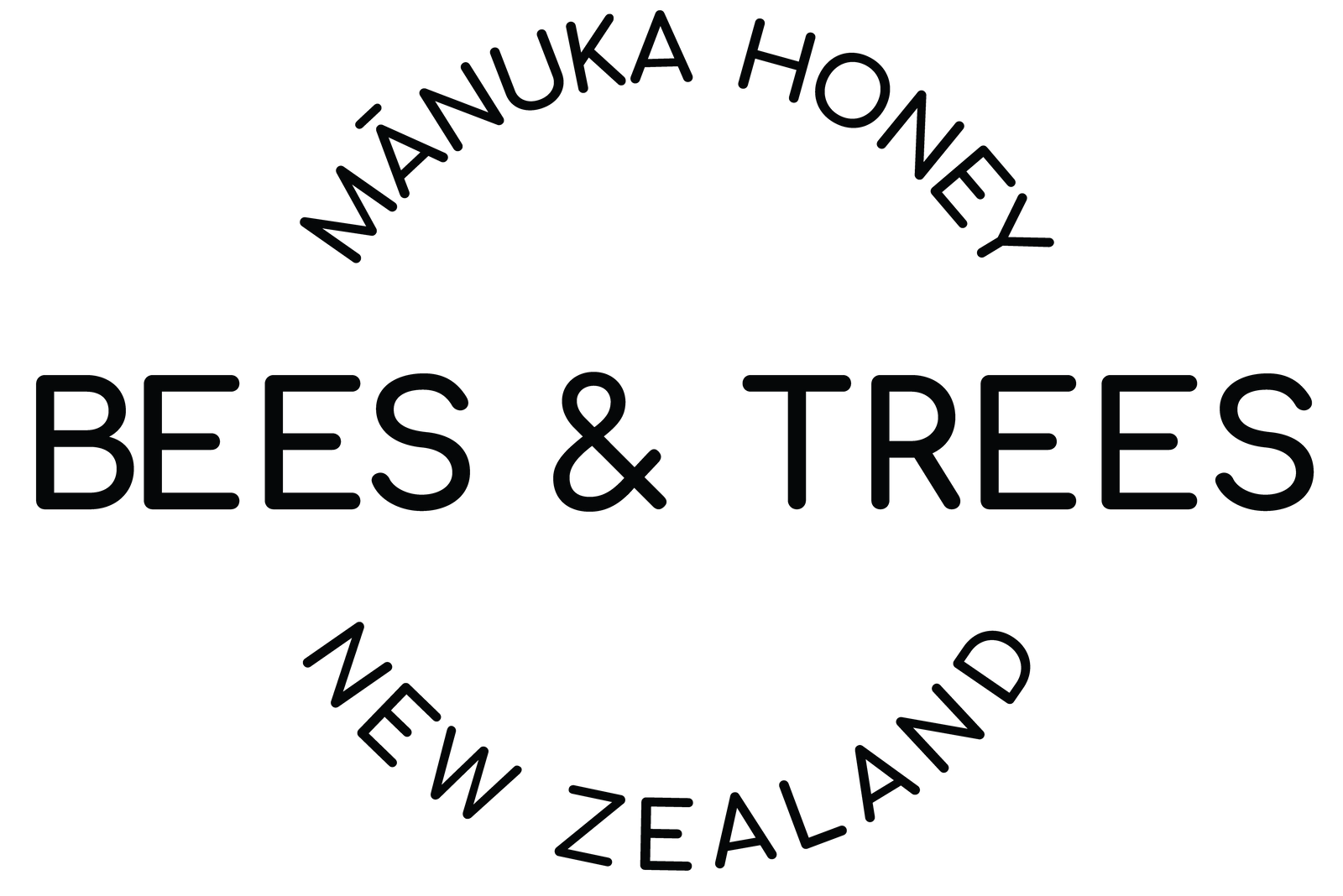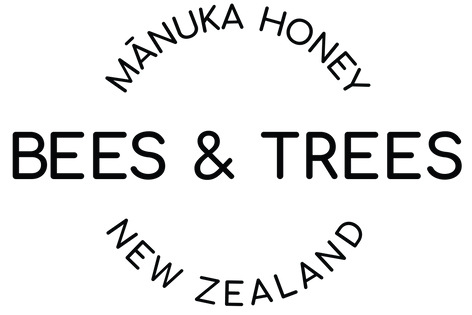History of Manuka Activity Ratings & Labeling Confusion
Historically, there have been various approaches that Manuka honey producers have used to convey the actual, or perceived, levels of bioactivity in the honey. Recently, the New Zealand Government, through its Ministry for Primary Industries (or MPI) stepped in to regulate the labeling of Manuka honey. As a result, there are now only two industry recognized ways to properly label Manuka honey. Manuka honey should either be labeled with the actual MG test results (in mg/kg), or with a correlated rating on the UMF (Unique Manuka Factor) scale (see note 1). The correlation between MG & UMF is as follows:
Note 1 - This chart shows the correlation between a UMF rating and the MG concentration of the honey. To display the UMF trademark on the label the honey must also be tested for threshold levels of Leptosperin and Hydroxymethylfurfural (HMF). These are two of the 6 chemical markers, plus a DNA marker that are typically tested for on Manuka honey. Four of the six chemical markers, plus the DNA marker are required by the NZ government before Manuka honey can be exported.
When you see anything else on a label of honey purporting to be Manuka honey, you should steer well clear. Examples of what continues to show up on labels include: “Active 15+”, “Bio-Active 15+”, “Total Activity 15+”, “K-Factor 15+”. The 15 in these examples is just an example; you will find numbers ranging from 5-20 typically. The history behind all of the different rating systems, and the attempts to overstate the value of New Zealand honey that contains very little Manuka honey could be the subject of its own book.
Kanuka Honey
The Kanuka tree, which is a closely related plant, grows on the North and the South Islands of New Zealand. Honey from Kanuka trees does not share the same anti-bacterial or anti-inflammatory properties with Manuka. As a closely related plant to Manuka, historically the pollen found in Kanuka honey was virtually indistinguishable from Manuka pollen. So, beekeepers, predominantly on the South Island where less Manuka grows, have cropped Kanuka honey and then labeled it as Manuka honey. In some cases there may be honest mistakes with regard to what floral source the bees have foraged to produce the honey. In other cases, beekeepers are intentionally trying to pass off Kanuka honey as Manuka honey. Within the industry, sellers (producers) and buyers (packagers/resellers) rely exclusively on MG test results. High MG honey (600-800 mg/kg) can command 3-4 times the price of low MG honey (100-150mg/kg). An entirely separate market exists for really low MG honey (below say 50mg/kg), where producers and packers trade on pollen content. A pollen content test includes viewing a sample of the honey under a microscope, counting the total number of pollen particles, and then classifying each particle by plant source. The ratio of pollen from Manuka/Kanuka (remember the lab can’t distinguish between theses two) to total pollen is taken as a representation of the purity of the honey. The science behind using pollen count to determine honey type is notoriously flawed. The most easily understandable problem with this testing is that the bees often work one floral type for nectar, and other floral types for pollen. But, armed with a pollen count test and the difficulty distinguishing Kanuka from Manuka pollen many companies feel justified in putting Manuka on the label.
Under a best-case scenario, you have producers of low activity Manuka/Kanuka honey types trying to put as positive a marketing spin as possible on their product. In other cases, companies are acting in an outright unethical manner. While some research is showing that Kanuka honey has high antioxidant content, and may stand on its own merits some day for its health properties, it should not be labeled Manuka honey. Several industry groups tried in vain for years to establish Manuka Honey labeling guidelines. Finally, the New Zealand Government stepped in and took control, believing that the New Zealand brand was at risk in global markets due to this industry infighting and shady practices. The Ministry For Primary Industries released their Manuka honey labeling guidelines in July 2014, and these regulations took effect in January 2015. You can find these guidelines on the MPI website.
Provenance – Certainty of Origin
As with any high-value product, there are unscrupulous operators looking to pass-off illegitimate honey as being sourced from New Zealand. Fortunately, consumers have become more savvy and are demanding to know where their food comes from. Bees & Trees works with Oritain, a New Zealand company who certifies the geographic origin of specific foods, including honey. Oritain has developed a very effective science based method for doing this. Using stable isotope markers, they are able to take soil samples from the apiary sites and then match these same markers in the honey produced from those sites. This “geochemical fingerprinting” allows companies to have independent certification as the geographic origin of the honey. Not just that it comes from New Zealand, which they can prove, but that it comes from a certain region in New Zealand, effectively putting a pin in the map. We think this is pretty cool science. You can find out more on Oritain’s website.
Only a handful of New Zealand honey producers are so far making this additional investment in protecting their brand and authenticating the origin of their honey. The large corporate players in the Manuka market are not able to do so due to a key aspect of their “production” process—blending. Much of the Manuka honey sold under the big name labels is purchased in bulk from honey producers all over New Zealand. The honey is then blended to achieve a certain MG or UMF rating. Notice how producers will sell a 250, a 400, and a 550 MG honey, but never, say, a 430. Or a 10+ or 15+, but not a 12+ UMF honey. Most of the honey going into these “production batches” is probably Manuka honey, but it does not necessarily need to be. Under this model, the goal is the rating number. This is a bit like making wine by blending a bunch of different grapes, not in an artisanal manner to achieve a great taste, but in a chemistry based exercise to achieve a certain alcohol content level. This is one of the reasons the predominant package choice for a lot of Manuka honey brands is a brown opaque plastic container. By using this package, these brands avoid the questions that would arise as different jars of what should be the same honey sit on a retail shelf showing distinctly different coloring.
If you are using Manuka honey topically, for skin care or wound care applications, blending should not be of concern. If however, you are consuming your Manuka honey daily on toast, in yogurt, in a cup of tea, or just straight from the jar, then you might think twice about what happens between the hive and the jar. Manuka honey that is packed by extraction batch, hive-to-jar without blending or additional process steps has all the wonderful health benefits and the added bonus of being a marvelous tasting gourmet food. That is the win-win consumers deserve when purchasing such a premium product.


